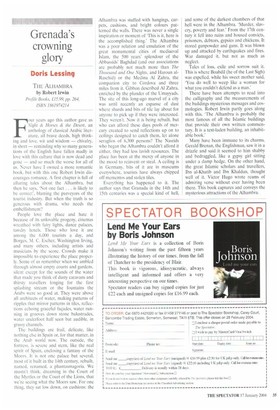Grenada's crowning glory
Doris Lessing
THE ALHAMBRA by Robert Irwin Profile Books, £15.99, pp. 264, ISBN 1861974214
Four years ago this author gave us Night & Horses & the Desert, an anthology of classical Arabic literature, all brave deeds, high thinking and love, wit and wisdom — chivalry, in short — reminding why so many generations of the English have fallen madly in love with this culture that is now dead and gone — and so much the worse for all of us. Never have I owned a more romantic book, but with this one Robert Irwin discourages romance. A first chapter is full of alluring tales about the Alhambra, but then he says, 'Not one fact . . . is likely to be correct', blaming the purveyors of the tourist industry. But when the truth is so generous with drama, who needs the embellishment?
People love the place and hate it because of its unlovable progeny, cinemas wreathed with fairy lights, dance palaces, tawdry hotels. Those who love it are among the 6,000 tourists a day, and Borges, M. C. Escher, Washington Irving, and many others, including artists and musicians by the score. Crowds make it impossible to experience the place properly. Some of us remember when we ambled through almost empty courts and gardens, silent except for the sounds of the water that made you think of dusty caravans and thirsty travellers longing for the first splashing stream or the fountains the Arabs were so good at. They were above all architects of water, making patterns of ripples that mirror patterns in tiles, reflections echoing graceful façades, water running in grooves down stone balustrades, water underfoot half seen but audible, in grassy channels.
The buildings are frail, delicate, like nothing else in Spain or, for that matter, in the Arab world now. The outside, the fortress, is severe and stern, like the real spirit of Spain, enclosing a fantasy of the Moors. It is not one palace but several, most of it built in the 14th century, rebuilt, named, renamed, a phantasmagoria. We mustn't think, dreaming in the Court of the Myrtles or the Court of the Lions, that we're seeing what the Moors saw. For one thing, they sat low down, on cushions: the Alhambra was stuffed with hangings, carpets, cushions, and bright colours patterned the walls. There was never a single inspiration or moment of 'This is it, here is the accomplished thing.' The Alhambra was a poor relation and emulation of the great monumental cities of mediaeval Islam, the 500 years' splendour of the Abbassids' Baghdad (and our associations are probably not much more than The Thousand and One Nights, and Haroun alRaschid) or the Medina Al Zahra, the companion city to Cordova and three miles from it. Gibbon described Al Zahra, enriched by the plunder of the Umayyads. The site of this long-ago marvel of a city was until recently an expanse of dust where shards and bits of tile lay about for anyone to pick up if they were interested. They weren't. Now it is being rebuilt, but who can afford these days pools of mercury, created to send reflections up on to ceilings designed to catch them, let alone seraglios of 6,300 persons? The Nasrids who began the Alhambra couldn't afford it either, they had less lavish resources. The place has been at the mercy of anyone in the mood to reinvent or steal. A ceiling is in Germany, bits of it are in museums everywhere, tourists have always chipped off mementos and stolen tiles.
Everything has happened to it. The author says that Granada in the 14th and 15th centuries was a special kind of hell, and some of the darkest chambers of that hell were in the Alhambra. 'Murder, slavery, poverty and fear.' From the 17th century it fell into ruins and housed convicts, prisoners, debtors, gypsies and chickens. It stored gunpowder and guns. It was blown up and attacked by earthquakes and fires. War damaged it, but not as much as neglect.
Tales of loss, exile and sorrow suit it. This is where Boabdil (he of the Last Sigh) was expelled, while his sweet mother said, 'You do well to weep like a woman for what you couldn't defend as a man.'
There have been attempts to read into the calligraphy and the measurements of the buildings mysterious messages and cosmologies. Robert Irwin partly goes along with this. 'The Alhambra is probably the most famous of all the Islamic buildings that provide their own written commentary. It is a text-laden building, an inhabitable book.'
Many have been immune to its charms. Gerald Brenan, the Englishman, saw it in a drizzle and said it seemed to him shabby and bedraggled, like a gypsy girl sitting under a damp hedge. On the other hand, the great Islamic scholars and travellers. Ibn al-Khatib and Ibn Khaldun, thought well of it. Victor Hugo wrote reams of admiring verse without ever having been there. This book captures and conveys the mysterious attractions of the Alhambra.


































































 Previous page
Previous page